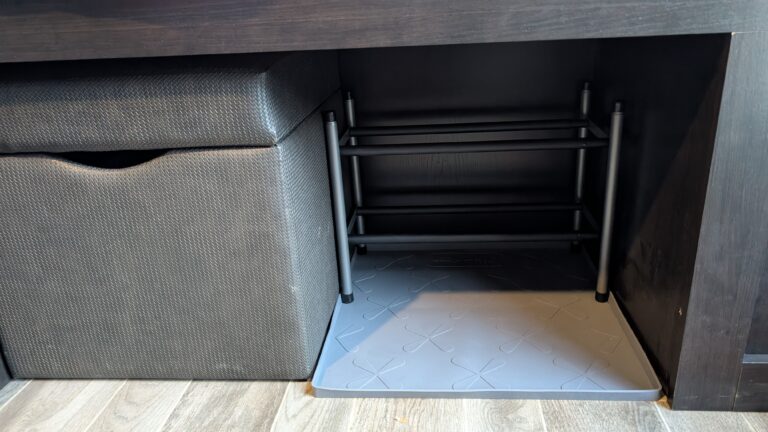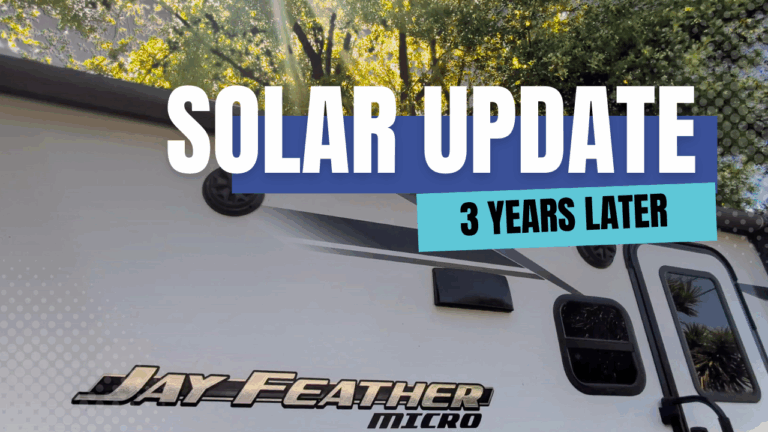To be safe, we wanted to add a tire pressure monitoring system or a TPMS to our trailer. Our tow vehicle already has a TPMS system and we only have a single axle trailer. So we just wanted a simple TPMS system with two sensors.
Rogina Roaming is supported by its audience. When you purchase through links on our site, we may earn an affiliate commission at no extra cost to you.
Single Axle Trailer TPMS Options
It turned out, finding a TPMS for a single axle trailer was a little bit more of a challenge than we were expecting. The two that everybody seems to go with are the TireMinder i10 or the TST 507. Both of those seemed like overkill to us.
Amazon has a ton of cheap options to choose from the problem with that is we weren’t really looking for cheap. We just wanted a small kit that was designed for a single axle with just two sensors, because that’s all that we needed. We wanted to still have a good quality system, something that we could trust. So we didn’t really want to cheap out. We just wanted a system that was right for single axle.
Now we did actually find an older TireMinder system that looked like it would be a really good fit. It was the TireMinder TRL2.
What we liked about it is it was designed for single axle. There were only two sensors and the screen displayed both the PSI and the temperature for both of those tires on the screen all the time. The reason why we didn’t go with that one is because it’s only rated to go up to 70 PSI. And the wheels on our trailer are rated to be at 80 PSI cold. So we needed something that could go higher.
TireMinder i10 vs TST 507
So we went back to the drawing board. Now, the reason why people tend to choose the TireMinder i10 is because it displays all of the wheels on one screen. But, it displays all of the PSI on one screen and then all of the temperatures on another screen. So for only two wheels, you’re not really getting any benefit by having everything on one screen.
Now on the TST TPMS, what people seemed to dislike about that one was it showed each wheel on a separate screen. So you see the temperature and the PSI for one wheel and then it rolls over and it shows the information for the next one and so on and so on.
So if you’re monitoring eight or ten wheels, I could definitely see why somebody wouldn’t want it to take so long to be able to see the stats for each individual wheel. But when you’re only monitoring two wheels, it’s not that big of a deal. It’s basically the same thing as the TireMinder i10. You’re still looking at two different screens. It’s just instead of the PSI and temp on one screen. Now it’s one wheel on one screen and the other wheel on the other.
Why we Chose the TST 507 TPMS
So we started leaning more towards the TST 507.
There’s a few other reasons why we liked that TPMS version over the TireMinder one. We like that you can also control the thresholds on it. So instead of it alerting you at a default percentage, you can actually change that threshold. For example, if I want to be alerted a little sooner or a little later, you can control that.
And the TST 507 does also have the option to use flow through sensors. So the little sensors that go on the tire, instead of having the cap over it, you can get ones that you could fill the tire through the sensor. So you’re not having to remove them to add more air to your tire. We didn’t get those, but it’s nice to know that that’s an option if we’d like to upgrade to that.
Another thing that we noticed is the TST 507 seems to be more expensive than the TireMinder i10. And that seems to be one of the reasons why a lot of people go with the TireMinder.
But, since we were only looking for two sensors, we actually were able to get a slightly better deal on the TST 507. The TST 507 has a package with only two sensors. For the TireMinder, the cheapest package that you could get had four sensors. So because of the different offerings, we actually were able to get the TST 507 for slightly cheaper than what you could get the TireMinder for. So that made it an easier decision because there really wasn’t a price difference there.
So those are the reasons why we decided to go with the TST 507 TPMS.
Installing the TST 507 TPMS
It was really easy to install. We just put the little sensors on our tires. We added a toolbox to our tongue recently, and we were able to put the signal booster right on the side of that. So that was really simple to install.
The first time we turned on the screen, it did take about 15 minutes for it to register the two sensors. But since that it is now much faster, it takes under a minute or so when we first turn it on for it to pick up the sensors.
My only complaint is that the screen could be a little bit brighter. The screen actually came with a visor that you can put over it, and that does help with the glare and being able to see it on those bright days. But it’s still not perfect. It could be better. You can see it, it just could be brighter and easier to see.
Conclusion
We’ve used this for over 1,500 miles so far, and it’s really worked out great. It’s nice to be able to see how the tires are doing, what the PSI is, and how warm they are. It is also a little bit nerve wracking, but it’s good information to have. It’s better to know than to not know. And we feel a lot more comfortable just knowing that we’re more aware of the current conditions of our tires.



